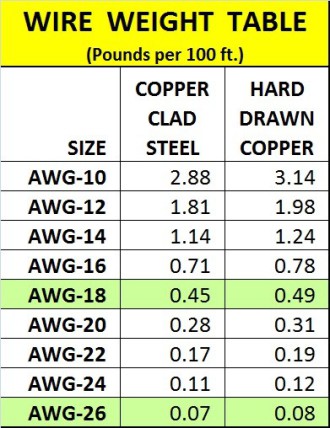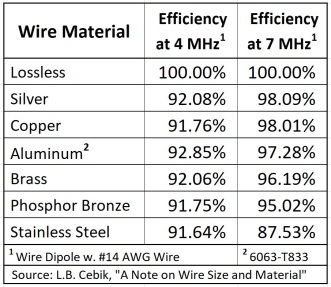ANTENNA WIRE
WIRE SIZE IS VERY IMPORTANT.
If you read most books on antenna theory,
you get the impression that the thicker the wire is,
the better it will be for performance.
A thick wire is always better than a thin wire.
FACT IS: THIS IS NOT A TRUE STATEMENT!
If you continue reading in the antenna book, you will also read that "height" is important for good performance with horizontal wires, such as dipoles, AND "length" (again height) is also important for good performance from vertical antennas on the low bands.
Using a fiberglass pole helps us get exteded heights for our wire antennas, without having to spend a fortune on the pole or mast. However if the wire we are using is too heavy (too thick), we risk breaking the pole.
SO THE REAL QUESTION IS, WHICH IS BETTER? MORE HEIGHT OR THICKER WIRE?
The ANSWER is: More Height . . . as long as the wire is not too thin.
This is a rare case where a compromise turns out to be the very best solution!
Spiderbeam, one of the industry's leaders in providing wire antenna solutions for use with fiberglass poles, recommends two wire sizes for use with its poles: AWG-18 and AWG-26.
In general AWG-18 is preferred, but when used as Top-Hat wires where the wire attaches horizontally or diagonally to the top (thin part) of the pole, Spiderbeam recommends AWG-26.
The table on the right shows the typical weights of various sizes of hard-drawn copper and copper clad (Copperweld) wire.
The weights shown are for bare wire, not for insulted wire. If you add insulation, it increases the weight slightly, but the relation of weight to wire size remains the same.
Spiderbeam recommends AWG-18 for normal use and AWG-26 for Top-Hat wires on wire verticals.
You often see AWG-12 recommended in text books. As you see, it weighs 4x as much as AWG-18.
When a horizontal wire is attached near the top of a lightweight telescoping fiberglass pole, the problem of weight is compounded by the force from the leverage that the long wire asserts on the pole.
CHOOSING THE WRONG WIRE
CAN LEAD TO BREAKAGE OF THE POLE.
Wire Types
Hams tend to use anything they can get for free (or relatively cheap) for antenna wire. In some cases this is OK, especially if only for temporary use, but in other cases (i.e., OCFD antennas) it can be disasterous.
Soft-drawn copper wire stretches, epsecially when the wire is long. This is the wire commonly found in hardware stores (i.e., Lowes, Home Depot, etc.).
- When used in an 80m dipole, the resonant frequency will begin to creep downwards over time.
- When used in an 80m OCFD antenna, it can stretch enough to move resonance out of band on the higher harmonic bands.
I strongly suggest sourcing wire from reputable ham radio stores. They sell hard-drawn copper antenna wire, which does not stretch (at least no much).
Copper-Weld Wire - steel wire coated with a thin layer of copper, offers a good compromise between size/weight and conductivity. This is typically no compromise in performance on 40m and above and even very little loss on 80m. On 160m, "Skin Effect" is not as predominant as on the higher bands. The RF penetrated deeper inside of the conductor(s). Thus somewhat loss is inevitable. However, since the wire is so long on this band, many people use copper-weld wire anyway.
Stranded (Litz) vs. Solid Wire: I have heard arguments for both. I prefer stranded wire for portable use, where the antenna will be erected and taken down often. I has less tendency to kink than solid wire. When wire kinks, it may possibly break at the kink.
I do not have facts showing that either one is significantly better than the other.
Insulated vs. Uninsulated Wire: Electrically, there is no noticible difference. I prefer insulated wire, but the insulation must be UV-resistant. Again, wire purchased at the local hardware store may not be UV-resistant.
Wire Material
Copper wire is the most commonly used wire in antennas, but there are other choices. The table below compares various material that might be considered for use in antennas:
When viewing the table above, notice that all types have less than 10% loss (except for stainless steel in the 40m dipole). 10% loss may sound like a lot but it is really just peanuts: <½ dB. This equates to 1/12 of an S-Unit.
The difference between silver/copper/aluminum is less than 1%. This equates to just 0.04 dB difference. FORGET IT!
SUMMARY AND CONCLUSION:
When choosing wire type and material, it is often a trade-off between additional d.c. loss of thinner wire, vs. dB gain when the thinner wire can be erected substantially higher than a thicker wire.
Keep in mind where and how the antenna will be used.
- The type (and strength) of the pole/mast plays an important role in the decision criteria.
- Most of us do not have a 60 ft. high steel tower in our back yard to support our wire antennas. If you do, then you can use thick, heavy wire.
- When using fiberglass poles, especially lightweight telescoping poles, use thinner wire and mount the antenna as high as you possibly can.
D.C. loss in wire is usually fractions of a dB, whereas gain achieved by increased height is sometimes multiple dB.
Remember: A thin wire mounted high in the air will out-perform a thick wire that is much lower to the ground.



























